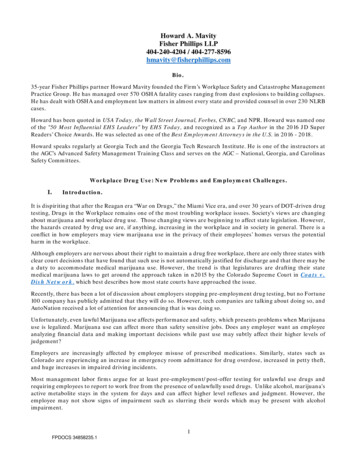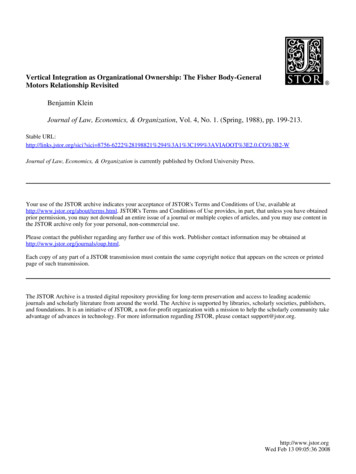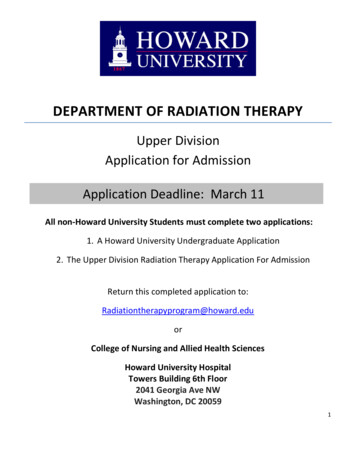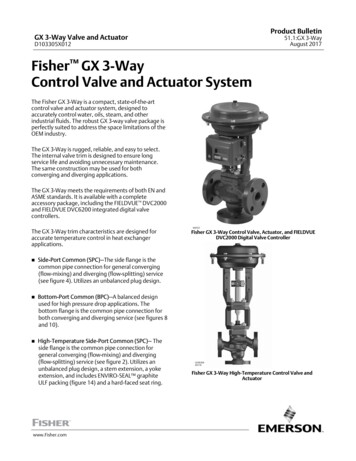
Transcription
Howard A. MavityFisher Phillips LLP404-240-4204 / 404-277-8596hmavity@fisherphillips.comBio.35-year Fisher Phillips partner Howard Mavity founded the Firm’s Workplace Safety and Catastrophe ManagementPractice Group. He has managed over 570 OSHA fatality cases ranging from dust explosions to building collapses.He has dealt with OSHA and employment law matters in almost every state and provided counsel in over 230 NLRBcases.Howard has been quoted in USA Today, the Wall Street Journal, Forbes, CNBC, and NPR. Howard was named oneof the "50 Most Influential EHS Leaders" by EHS Today, and recognized as a Top Author in the 2016 JD SuperReaders’ Choice Awards. He was selected as one of the Best Employment Attorneys in the U.S. in 2016 - 2018.Howard speaks regularly at Georgia Tech and the Georgia Tech Research Institute. He is one of the instructors atthe AGC’s Advanced Safety Management Training Class and serves on the AGC – National, Georgia, and CarolinasSafety Committees.Workplace Drug Use: New Problems and Employment Challenges.Introduction.It is dispiriting that after the Reagan era “War on Drugs,” the Miami Vice era, and over 30 years of DOT-driven drugtesting, Drugs in the Workplace remains one of the most troubling workplace issues. Society's views are changingabout marijuana and workplace drug use. Those changing views are beginning to affect state legislation. However,the hazards created by drug use are, if anything, increasing in the workplace and in society in general. There is aconflict in how employers may view marijuana use in the privacy of their employees’ homes versus the potentialharm in the workplace.Although employers are nervous about their right to maintain a drug free workplace, there are only three states withclear court decisions that have found that such use is not automatically justified for discharge and that there may bea duty to accommodate medical marijuana use. However, the trend is that legislatures are drafting their statemedical marijuana laws to get around the approach taken in n2015 by the Colorado Supreme Court in Coats v.Dish Network, which best describes how most state courts have approached the issue.Recently, there has been a lot of discussion about employers stopping pre-employment drug testing, but no Fortune100 company has publicly admitted that they will do so. However, tech companies are talking about doing so, andAutoNation received a lot of attention for announcing that is was doing so.Unfortunately, even lawful Marijuana use affects performance and safety, which presents problems when Marijuanause is legalized. Marijuana use can affect more than safety sensitive jobs. Does any employer want an employeeanalyzing financial data and making important decisions while past use may subtly affect their higher levels ofjudgement?Employers are increasingly affected by employee misuse of prescribed medications. Similarly, states such asColorado are experiencing an increase in emergency room admittance for drug overdose, increased in petty theft,and huge increases in impaired driving incidents.Most management labor firms argue for at least pre-employment/post-offer testing for unlawful use drugs andrequiring employees to report to work free from the presence of unlawfully used drugs. Unlike alcohol, marijuana'sactive metabolite stays in the system for days and can affect higher level reflexes and judgment. However, theemployee may not show signs of impairment such as slurring their words which may be present with alcoholimpairment.1FPDOCS 34858235.1
Unlike for alcohol, no urine or blood drug test has yet been devised where the result will be treated as proof ofimpairment or of being under the influence. Various states and provinces have passed laws establishing presumptiveor per se amounts of THC in one’s blood, but their legal effectiveness has not yet been determined. Field sobrietytests may also still be utilized.The best evaluation of employee unlawful drug use trends is the annual Quest Diagnostics survey. Every yearQuest parses its 10 million workplace drug test results.For the last few years unlawful drug use has increased after almost 16 years of decline. Prescription opiate positiveshave skyrocketed, but finally declined a little bit last year. This reflects the government's attacks on “pill mills” andphysicians over-prescribing opiates. Nevertheless, the problem is not yet addressed. Nature abhors a vacuum andso does drug use. As prescription opiate abuse drops, black tar heroin consumption rises.Similarly, methamphetamine positive has skyrocketed in certain areas.Even cocaine use has reappeared in many areas.Nagging Questions Facing Employers.Employers are asking: Should I still drug test?What drugs should I test for?Can I refuse to hire an employee who uses medical marijuana?Do I have to accommodate an employee who uses medical marijuana?How do I know if the Medical Marijuana use is valid?Is Cocaine still a problem?How do I deal with Opiate issues?The Changing Environment. WSJ: “Wall Street’s Marijuana Madness: ‘It’s Like the Internet in 1997.’” Investors have begun to invest inCanada and even the U.S.The giant Constellation Brands bought a large stake in the Marijuana Industry in 2018.October 2017 Gallup Poll – 64% favor legalization of Marijuana.Depending on which Poll one reads, as many as 1 in 5 have used Marijuana.Companies such as AutoNation and some tech firms no longer conduct pre-employment drug testing. SunSentinel Article.Employers in States with legal Marijuana are more likely to cease testing. (2017 Mountain States EmployerAssociation example).In the 2018 election, Michigan and Missouri passed new Marijuana laws and more are expected in 2019.Over 30 States have Med Marijuana laws.Approximately a 3.7% unemployment rate.As a result, more employers are hiring employees with no high school degree – the unemployment rate ofapplicants with no high school degree has gone from an unemployment rate of 6.5% to 5.5%.WSJ: Low Unemployment, Slow Wage Growth Bring Renewed Labor Strife.Approximately 57% of employers still drug test.Almost all Fortune 500 Companies engage in some type of drug testing.Businesses with “Safety Sensitive” positions, or who do work with the Government, or who are in heavilyregulated industries test and have lower positive rates.Industries with more injuries or “higher hazard” industries experience more Opiate positive test results.2FPDOCS 34858235.1
Different regions have markedly different patterns of positive drug test results and have different varietiesof drug problems.DOT/FMCSA Drug Test requirements have resulted in lower positive rates for affected industries.Most behavioral and physiological effects of marijuana use return to baseline levels within 3-5 hours after druguse, although some investigators have demonstrated residual effects in specific behaviors up to 24 hours, suchas complex divided attention tasks. Psychomotor impairment can persist after the perceived high has dissipated.In long term users, even after periods of abstinence, selective attention (ability to filter out irrelevantinformation) declines.The speed of information processing has been shown to be impaired with increasing frequency of use.Stronger doses may cause fluctuating emotions, flights of fragmentary thoughts with disturbed associations,a dulling of attention despite an illusion of heightened insight, image distortion, and psychosis.After alcohol, marijuana is the most frequently detected psychoactive substance among driving populations.NHTSA.gov Report.NHTSA Report: Marijuana Impairs.Smoking marijuana has been shown to affect a number of driving-related skills. Laboratory,simulator and instrumented vehicle studies have shown that marijuana can impair critical abilitiesnecessary for safe driving, such as: Slow reaction time, for example, responding to unexpected events - emergency braking (Casswell, 1977;Smiley et. al., 1981; Lenné, M.G., et al., 2010);Cause problems with road tracking - lane position variability (Smiley, et. al., 1981; Robbe and O'Hanlon,1993; Ramaekers, 2004)Decrease divided attention - target recognition (Smiley, 1999; Menetrey, et. al., 2005), impair cognitiveperformance - attention maintenance (Ramaekers, et. al., 2004); and impair executive functions - routeplanning, decision making, and risk taking (Dott, 1972, Ellingstad et al, 1973; Menetrey, et al., 2005).Marijuana Impaired Driving – July 2017 Report to Congress.Section I: Traffic Fatalities & Impaired Driving Since recreational marijuana was legalized, marijuana related traffic deaths increased 151 percent while allColorado traffic deaths increased 35 percentSince recreational marijuana was legalized, traffic deaths involving drivers who tested positive for marijuanamore than doubled from 55 in 2013 to 138 people killed in 2017.This equates to 1 person killed every 2 1/2 days compared to one person killed every 6 1/2 days.The percentage of all Colorado traffic deaths that were marijuana related increased from 11.43 percent in2013 to 21.3 percent in 2017.Section II: Marijuana Use Colorado past month marijuana use shows a 45 percent increase in comparing the three-year average priorto recreational marijuana being legalized to the three years after legalization.Colorado past month marijuana use for ages 12 and older is ranked 3rd in the nation and is 85 percent higherthan national average.Section III: Public Health The yearly rate of emergency department visits related to marijuana increased 52 percent after thelegalization of recreational marijuana. (2012 compared to 2016)The yearly rate of marijuana-related hospitalizations increased 148 percent after the legalization ofrecreational marijuana. (2012 compared to 2016)3FPDOCS 34858235.1
Marijuana only exposures more than tripled in the five-year average (2013-2017) since Colorado legalizedrecreational marijuana compared to the five-year average (2008-2012) prior to legalization.Section IV: Black Market RMHIDTA Colorado Task Forces (10) conducted 144 investigations of black market marijuana in Coloradoresulting in:239 felony arrests7.3 tons of marijuana seized43,949 marijuana plants seized24 different states the marijuana was destinedThe number of highway seizures of Colorado marijuana increased 39 percent from an average of 242seizures (2009-2012) to an average of 336 seizures (20132017) during the time recreational marijuana hasbeen legal.Seizures of Colorado marijuana in the U.S. mail system has increased 1,042 percent from an average of 52parcels (2009-2012) to an average of 594 parcels (2013-2017) during the time recreational marijuana hasbeen legal.Section V: Societal Impact Marijuana tax revenue represent approximately nine tenths of one percent of Colorado’s FY 2017 budget.Violent crime increased 18.6 percent and property crime increased 8.3 percent in Colorado since 2013.65 percent of local jurisdictions in Colorado have banned medical and recreational marijuana businesses.Positive test rates fell from a whopping 13.6% in 1988 to 3.5% in 2012 – 20 years of decline. In 2013, theybegan to rise again, led by a staggeringly fast rise in opiates positivity.From the Quest Diagnostic’s May 8, 2018 release of its analysis of 10,000,000 2017 drug test results:Good News Prescription opiate positivity rate drops, but for the fifth year, Cocaine rose by double digits incertain states: Nebraska (91% increase between 2016 and 2017),Idaho (88% increase),Washington (31%),Nevada (25%),Maryland (22% increase), andWisconsin (13%)Between 2013 and 2017, methamphetamine positivity skyrocketed, especially in Midwestern and Southernstates: 167% in the East North Central division of the Midwest (Illinois, Indiana, Michigan, Ohio, Wisconsin);160% in the East South Central division of the South (Alabama, Kentucky, Mississippi, Tennessee);150% in the Middle Atlantic division of the Northeast (New Jersey, New York, Pennsylvania); and140% in Delaware, D.C., Florida, Georgia, Maryland, North Carolina, South Carolina, Virginia, WV.Marijuana positivity rises considerably in states that recently enacted recreational use statutes, finds nationalanalysis by Quest Diagnostics. May 8, 2018 Quest Diagnostics Annual Drug Testing Index.More Americans die of overdoses than in car crashes and gun homicides combined.In 2016, 64,000 people died due to drug abuse. 23% related to prescription pain relievers.24% related to heroin.31% related to non-methadone, synthetic opioids (e.g., fentanyl)In 2016, over 11.8 million people used heroin or misused prescription opioid pain relievers.4FPDOCS 34858235.1
In 2015, 919,400 people 25 – 54 years old were not in labor force due to their opioid use. From 1999-2015, the decline in labor force participation cumulatively cost economy 12.1 billion work hours.During that period, the reduction in work hours slowed real annual economic growth rate by 0.2%, whichtranslates to around 702.1 billion in real output.American Action Forum (AAF), “The Labor Force And Output Consequences Of The Opioid Crisis”(March 2018).A Massachusetts Department of Public Health report broke down opioid-related overdose deaths by industryand occupation 2011 - 2015 and found:“The rate of fatal opioid-related overdose was higher among workers employed in industriesand occupations known to have high rates of work-related injuries and illnesses.” Construction and extraction: 150.6 deaths per 100,000 workersMaterial moving occupations: 59.1 deaths per 100,000 workersInstallation, maintenance, and repair occupations: 54.0 deaths per 100,000 workersTransportation occupations: 42.6 deaths per 100,000 workersProduction occupations: 42.1 deaths per 100,000 workers A recent hospital emergency room study showed that 35% of patients with an occupational injury wereat-risk drinkers.Breathalyzer tests detected alcohol in 16% of emergency room patients who were injured at work.Large federal surveys show that 24% of workers admit to drinking in the workplace at least once in thepast year. By 2016, over 30 million people used an illicit drug in the previous 30 days - about 1 in 10 Americans.In 2016, 23 million used marijuana in the previous 30 days.In 2016, about 4.5 million people reported nonmedical use of prescription pain relievers.According to one reputable recent analysis, Drug-using employees are: 2.2 times more likely to request early dismissal or time off,2.5 times more likely to have absences of eight days or more,3 times more likely to be late for work,3 times more likely to be involved in a workplace accident, and5 times more likely to file a workers’ compensation claim.Medicinal Marijuana Use.There are perhaps 4 million medicinal marijuana users and the number is growing. Prescribed with increased frequency for ailments such as glaucoma, cancer, HIV, Hepatitis-C, MS, andSeizure disorders.Pain relief benefits are still debated.FDA has yet to approve it for medical use (THC is approved, however).Deemed a Schedule 1 controlled substance with high potential for abuse.AMA does not fully support medical use, but only further investigation.Most State Laws list the applicable conditions warranting use.May limit to cannabis oil and percentage.Most Recent Data on States with highest workplace positivity test rate for Marijuana.5FPDOCS 34858235.1
Marijuana positivity for the American workforce is up for the fifth consecutive year, a trend showing no signs ofslowing. Drug positivity in states without marijuana use statutes has kept pace with the national average of 2.1%for the combined U.S. workforce. However, data from Quest Diagnostics shows that the states with the highestpositivity rates do not necessarily contain the cities or metropolitan areas with the highest marijuana positivity.Quest Diagnostics interactive drug testing map reveals the 10 states with the highest marijuana positivity rates in2017, averaging 2.96%.1.2.3.4.5.6.7.8.9.10.Oregon (3.9%)Maine (3.5%)Massachusetts (3.1%)Rhode Island (3.1%)Vermont (2.9%)Michigan (2.8%)Nevada (2.7%)Washington (2.6%)Arizona (2.5%)Colorado (2.5%)Overview of State Marijuana Laws: Legal Recreational Marijuana – 11 the District of ColumbiaLegal Medicinal Marijuana – 33 states and growingLegal (CBD) for Medical Use – 44 statesOver 100 million Americans live in states allowing some form of marijuana useIn 2018, marijuana was an 8 billion dollar industry, with 21.8 billion projected by 2020 – somespeculate 100 million by then.An Explanation of Marijuana. Delta 9–Tetrahydrocannabinol (THC) - impairs.(CBH) – modulates some psychotropic effects of THC, may have medical benefits, debated whether mayimpair users. At least one Cannabinol product FDA approved.Resources: NHTSA Risky Driving Drug-Impaired DrivingMarijuana Impaired Driving – July 2017 Report to Congress.References studies: 1973, 1977, 1981, 1999, 2004, 2005, 2010).Medical uses of CBDMedical uses of eantAnalgesicAppetite stimulantAnti-tumor effectsReduces glaucoma symptomsAnti-psychoticSleep aid6FPDOCS 34858235.1
Inflammatory bowel diseaseAnti-anxietyDepressionMuscular spasticityResources:Analytical Cannabis – Article – What are the Main differences between CBD and THC?Only FDA-approved Prescription Canabinol – Epidiolex (cannabinol) - FDA approves first drug comprised ofan active ingredient derived from marijuana to treat rare, severe forms of epilepsy. Food and DrugAdministration website. ncements/ucm611046.htm. Accessed June 29, 2018.Blood testing is preferred for attempting to ascertain impairment in a criminal setting but is not yet effective orrecognized.There is not yet an accepted test result that is alone legal and technical proof of Marijuana Impairment.Alcohol is blood soluble – THC is fat soluble and can be released into blood long after ingestion.The primary psychoactive substance in marijuana is delta-9-tetrahydrocannabinal (THC). THC is one ofover 500 known compounds in the cannabis plant, including more than 80 other cannabinoids. THC isassociated with the psychoactive effects of ingesting marijuana plant material. THC has been shown to bindwith receptors in the brain (and to a lesser extent in other parts of the body) and it is likely that this processunderlies some of the psychoactive (behavioral and cognitive) effects of marijuana use.While ethyl alcohol is readily soluble in water, and hence blood, THC is fat soluble. This means that onceingested, THC is stored in fatty tissues in the body and can be released back into the blood sometimes longafter ingestion. Some studies have detected THC in the blood at 30 days post ingestion (Heustis, 2007).Thus, while THC can be detected in the blood long after ingestion, the acute psychoactive effects ofmarijuana ingestion last for mere hours, not days or weeks. Also, unlike alcohol, which is metabolized at asteady rate, the metabolism of THC occurs in a different fashion such that THC blood levels declineexponentially. Some studies have reported a fairly wide variability that is affected by the means of ingestion(smoking, oil, and edibles), potency, and user characteristics. Most research on the effects of marijuana hasused smoking and often do not measure the concentration of THC in the blood. July 2017 NTTSA MarijuanaImpaired Driving: A Report to Congress. p 4.7FPDOCS 34858235.1
The decline of alcohol is predictable – THC is not. July 2017 NTTSA Marijuana-Impaired Driving: AReport to Congress. p.3.The amount of alcohol in the bloodstream is closely related to impairment, but not THC. See theabove Report.In summary, ethyl alcohol is a relatively simple drug whose absorption, distribution and eliminationfrom the body along with the behavioral and cognitive effects are fairly well documented. July 2017NTTSA Marijuana-Impaired Driving: A Report to Congress. p.9.Criminal Law – There is only a limited ability to prove impairment based on Blood Alcohol Content(BAC). Field Sobriety tests may still be necessary.Generally, prosecution on a drug-impaired driving offense will include evidence that the driver hadused a specific potentially impairing drug, and that an observed impairment likely resulted fromthat drug use. It is difficult, though not impossible, to obtain a conviction for drug-impaired drivingwithout evidence of drug use by the suspect. For example, a suspect may refuse to provide aspecimen for testing and/or the officer may be unable to obtain a search warrant in a timelyfashion.Evidence of drug use is typically obtained by the investigating law enforcement officer (physicalevidence, odor of marijuana use, etc.), but most often comes from forensic testing conducted in alaboratory of a biological specimen taken from the suspect. Laboratory testing of biologicalspecimens can be time consuming and expensive. July 2017 NTTSA Marijuana-Impaired Driving: AReport to Congress. p 9 Illegal everywhere in America to drive under the influence of alcohol, marijuana, opioids,methamphetamines, or any potentially impairing drug–prescribed or over the counter.15 States’ Zero Tolerance Laws prohibit the presence of any drugs.At least five states present the presence of any “prohibited drugs.”Several States have stablished a specific BAC result such as 5 nanograms of THC per millilitre ofblood.Applicable Employment Laws The Americans with Disabilities Act (ADA)State and Local Disability and Discrimination Laws.Family and Medical Leave Act (FMLA).State Drug Laws regulating how testing is carried out.State Laws protecting Legal Off-duty Activities.State Medical and Recreational Marijuana laws.Fed/State DOT/Motor Carrier Safety regulations.OSHA Interpretations. Drug and alcohol addiction is considered a disability.A rehabilitated drug or alcohol addict is protected under the ADA.A Leave of absence for rehabilitation may be considered reasonable accommodation (beforeviolation of policy is detected).A “current” user of illegal drugs is not protected under the ADA.A “current” user of alcohol is protected under the ADA, but may be disciplined for violatingCompany policy or work rule, depending on facts (case-by-case basis). FPDOCS 34858235.1
The EEOC has stated that “current” means “recently enough” to justify the employer’s reasonablebelief that drug use is an ongoing problem.Courts have indicated that “currently engaging” is not limited to “the day of” or even within a matterof days or even weeks before the employment act (i.e. workplace accident) took place.It is intended to apply to the illegal use of drugs that has occurred recently enough to indicate thatthe individual is actively engaged in illegal drug use.The EEOC regulations explain that “individuals disabled by alcoholism are entitled to the sameprotections accorded other individuals with disabilities.”Although courts generally do not consider alcoholism a “per se” disability – an alcoholic is a personwith a disability when the condition “substantially limits” him or her in at least one “major lifeactivity.”The ADA also protects individuals who do not currently drink alcohol but have a record ofalcoholism.Employers may require an employee who is an alcoholic or engages in the illegal use of drugs tomeet the same performance standards of performance and behavior as other employees;Employers do not have to tolerate poor job performance or unsatisfactory behavior such asabsenteeism, tardiness, insubordination or on the job accidents related to an employee’s alcoholismor illegal use of drugs if similar performance or conduct would not be tolerated in other employees.The ADA specifically permits employers to prohibit the use of alcohol or drugs in the workplaceand to discipline employees for such use.Employers may maintain a drug free workplace standard.The FMLA provides twelve weeks of leave and reinstatement for employee with a “serious medicalcondition.”In most cases, drug addiction will be considered a “serious medical condition.”Substance Abuse Rehabilitation may count as FMLA leave.The Status of the Federal Controlled Substances Act and its Effect on State Laws.1. A high potential for abuse;2. No currently accepted medical use in treatment in the US; and3. Lack of accepted safety for use of it.Despite a multiyear push by numerous Democratic Congress members and various organizations, theObama Administration declined to change the Scheduling of Marijuana in an August 11, 2016 NoticeDEA Press Release. and DEA Controlled Substances.August 2016 Article on not the DEA’s decision to not Reschedule Marijuana:The DEA’s current approach and many helpful facts are contained in the 2017 DEA Guide to Drugs ofAbuse:On October 19, 2009, the U.S. Dept. of Justice (“DOJ”) issued a statement that it will not:“Focus federal resources in your states on individuals whose actions are in clear and unambiguouscompliance with existing state laws providing for the use of medical marijuana.”The DOJ approach reiterated this position in the 2013 Cole Memo:FPDOCS 34858235.1
Former Attorney General Sessions issued a new Memorandum on January 4, 2018, which unnervedproponents of marijuana legalization but has not yet resulted in changes in Federal enforcement.Analysis.The Supreme Court set the tone with Gonzales v. Raich, 541 U.S. 1 (2005) Congress may ban use of cannabis even where approved by states for medicinal useThe controlled Substances Act trumped California law (Prop. 215) pursuant to Commerce clauseBanning marijuana growth for medical use is a permissible way of limiting its access for other usesAs a result, employers in most states may safely refuse to accept medical marijuana as a reasonableexplanation for a positive test result. In 2008, California’s highest court found that the state’s medical marijuana law only protectsindividuals from criminal prosecution, ruling in favor of an employer who declined to hire aninjured vet using marijuana to treat chronic back pain after he failed his pre-employment drug test.In 2010, the Oregon Supreme Court handed employers a comprehensive victory, ruling thatmedical marijuana’s status as an illegal drug under federal law meant that no employer should beforced to accommodate it.In 2011, the Washington Supreme Court handed employers a similar victory, deciding thatemployers need not accommodate an employee's use of medical marijuana, and that employeesterminated for medical marijuana use – even offsite use – have no basis to sue their employers.In 2012, the Montana Supreme Court ruled that medical marijuana users and providers had nospecial right to their employment despite the state’s new law.This was followed by a unanimous 2015 Colorado Supreme Court decision holding that employerswere still free to prohibit employee marijuana use in their workforces, and can still discipline andterminate employees who test positive for the drug, despite state law permitting its medicinal (andrecreational) use.Most recently, in January 2016, a federal court judge in New Mexico dismissed a lawsuit broughtby an employee terminated after testing positive for the drug, finding that state law does notrequire employers to accommodate medical marijuana use.“We therefore agree with the Court of Appeals” “that the commonly acceptedmeaning of the term ‘lawful’ is ‘that which is ‘permitted by law’ or, conversely,that which is ‘not contrary to, or forbidden by law.’”The Court rejected argument that the General Assembly, in drafting CLODA, intended the term “lawful”to mean “lawful under Colorado state law.”“In sum, because Coats’s marijuana use was unlawful under federal law, it doesnot fall within [CLODA’s] protection for ‘lawful’ activities.”Having decided the case under Federal law, the court declined to address the second issued – whetherMedical Use Amendment makes use lawful.Examples of Developing State Law Issues about Marijuana.FPDOCS 34858235.1
Callaghan v. Darlington Fabrics Corp., 2017 WL 2321181. The “solely on the basis” clause was tested in Callaghan v. Darlington Fabrics Corp. where a youngwoman who used medical marijuana to treat Crohn’s disease applied for an internship. She wasoffered the position contingent on a drug test and she informed the employer that she would fail.Not surprisingly, she did fail and the employer rescinded the offer.In Court, the employer made several arguments, including the same argument everyone else hadsuccessfully used, i.e. that marijuana is illegal under federal law and therefore it was permitted torescind the offer.For the first time in the country, the trial court judge found that it was possible to bring such aclaim, regardless of federal law, and found that Rhode Island’s anti-disability discrimination statutewould support the plaintiff’s claim.The Court concluded that, as with the use of any properly prescribed medication, the use of lawfullyprescribed marijuana must be accommodated - Chief Justice Gants:“An exception to an employer’s drug policy to permit its use is a faciallyreasonable accommodation.”The Court left open the possibility that accommodating an employee’s use of medical marijuana couldpose an undue burden to employers, holding that the use of marijuana could impair performance orcause a safety issue, which would impose an undue burden on employers.Essentially the same analysis employers have been using for years with respect to employee use of otherlawful controlled substances.The Court also confirmed that the statute does not require employers to permit the use of medicalmarijuana in the workplace.Held that Connecticut employees who have received approval from the state agency to use medicalmarijuana outside of work cannot be fired just because they test positive for marijuana during a drugscreening.The court held that employees and job applicants can sue based on a termination or a rescinded joboffer.Examples of State Marijuana Laws.MissouriMedical marij
Howard speaks regularly at Georgia Tech and the Georgia Tech Research Institute. He is one of the instructors at the AGC's Advanced Safety Management Training Class and serves on the AGC - National, Georgia, and Carolinas Safety Committees. Workplace Drug Use: New Problems and Employment Challenges. Introduction.










